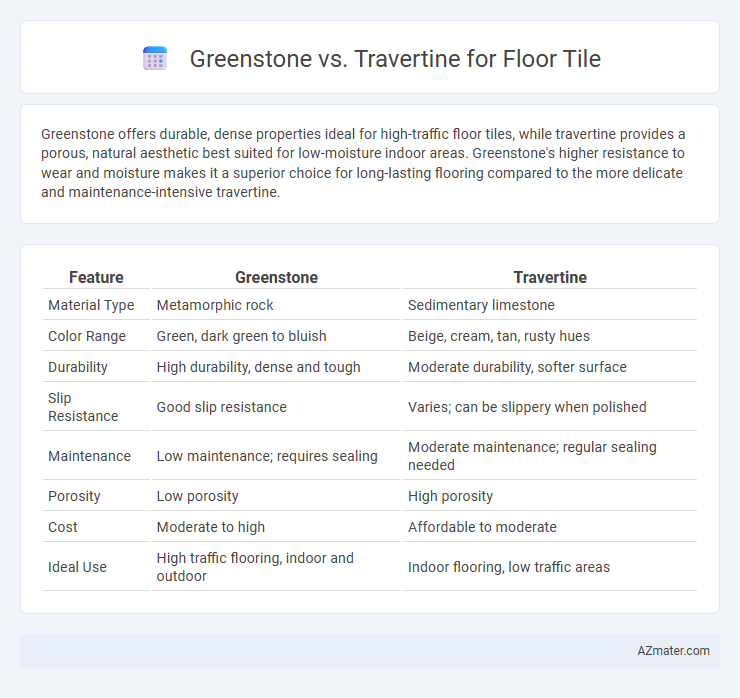Greenstone offers durable, dense properties ideal for high-traffic floor tiles, while travertine provides a porous, natural aesthetic best suited for low-moisture indoor areas. Greenstone's higher resistance to wear and moisture makes it a superior choice for long-lasting flooring compared to the more delicate and maintenance-intensive travertine.
Table of Comparison
| Feature | Greenstone | Travertine |
|---|---|---|
| Material Type | Metamorphic rock | Sedimentary limestone |
| Color Range | Green, dark green to bluish | Beige, cream, tan, rusty hues |
| Durability | High durability, dense and tough | Moderate durability, softer surface |
| Slip Resistance | Good slip resistance | Varies; can be slippery when polished |
| Maintenance | Low maintenance; requires sealing | Moderate maintenance; regular sealing needed |
| Porosity | Low porosity | High porosity |
| Cost | Moderate to high | Affordable to moderate |
| Ideal Use | High traffic flooring, indoor and outdoor | Indoor flooring, low traffic areas |
Introduction to Greenstone and Travertine Floor Tiles
Greenstone floor tiles are dense, durable, and naturally rich in shades of green, making them ideal for high-traffic areas with a luxurious, earthy aesthetic. Travertine floor tiles are formed from calcium carbonate deposits, exhibiting a porous texture with warm beige and cream tones, often used in both indoor and outdoor settings for their elegant, classic appeal. Both materials offer unique natural stone characteristics, with greenstone emphasizing hardness and durability, while travertine is prized for its distinctive veining and softer, timeless look.
Physical Characteristics: Greenstone vs Travertine
Greenstone features a dense, fine-grained texture with high durability and natural resistance to wear, ideal for high-traffic flooring. Travertine exhibits a porous, sedimentary structure characterized by distinctive holes and troughs, which often requires sealing to enhance its strength and longevity. Both materials offer unique physical properties, with greenstone providing exceptional hardness and travertine delivering natural thermal insulation.
Aesthetic Appeal and Design Versatility
Greenstone flooring offers a rich, earthy palette with deep greens and subtle textural variations, creating a natural and sophisticated ambiance ideal for contemporary and rustic designs. Travertine exhibits warm, neutral tones with distinctive pitted textures and veining, enhancing Mediterranean and classic interior styles with timeless elegance. Both stones provide versatile design options, but Greenstone leans toward bold, statement aesthetics while Travertine delivers understated luxury and seamless integration into diverse decor themes.
Durability and Longevity Comparison
Greenstone floor tiles offer exceptional durability due to their dense composition, making them highly resistant to scratches, chips, and wear in high-traffic areas. Travertine, while aesthetically appealing with its natural porous texture, requires regular sealing to maintain longevity and prevent stain absorption, making it less durable in moisture-prone environments. Over time, greenstone's hardness and low porosity contribute to superior lifespan and minimal maintenance compared to the relatively softer, more porous travertine tiles.
Slip Resistance and Texture Differences
Greenstone floor tiles offer a naturally textured surface with moderate slip resistance, making them suitable for both indoor and outdoor areas prone to moisture. Travertine tiles feature a porous, pitted texture that provides excellent grip but may require sealing to prevent stains and maintain slip resistance. Choosing between greenstone and travertine depends on the specific application where surface traction and maintenance needs are critical considerations.
Maintenance and Cleaning Requirements
Greenstone floor tiles require minimal maintenance, benefiting from their natural hardness and resistance to scratches, with regular sweeping and occasional damp mopping recommended to preserve their finish. Travertine tiles demand more careful cleaning due to their porous nature, necessitating periodic sealing and the use of pH-neutral cleaners to prevent staining and etching. Both materials benefit from avoiding acidic or abrasive cleaners to maintain their aesthetic appeal and longevity.
Environmental Impact and Sustainability
Greenstone boasts a lower environmental impact than travertine due to its abundance and minimal processing requirements, reducing quarrying damage and carbon footprint. Travertine, while durable, often involves intensive mining and chemical treatments that increase energy consumption and environmental degradation. Opting for greenstone floor tiles supports sustainable practices through renewable sourcing and lower emissions during production.
Cost Comparison: Greenstone vs Travertine
Greenstone floor tiles generally cost between $5 to $12 per square foot, while travertine tiles range from $3 to $10 per square foot, making travertine a more budget-friendly option. Installation costs for both materials average around $4 to $7 per square foot but can fluctuate based on tile size and surface preparation. Long-term maintenance expenses favor greenstone due to its higher durability and resistance to staining, which can reduce repair and replacement costs over time.
Best Applications for Each Stone Tile
Greenstone floor tiles excel in outdoor patios and walkways due to their durability, slip resistance, and ability to withstand harsh weather conditions. Travertine tiles are ideal for indoor spaces such as bathrooms, kitchens, and living rooms, offering a luxurious appearance with natural color variations and a polished finish. Both stones complement different design aesthetics, with greenstone enhancing rustic or natural looks, and travertine providing a classic, elegant ambiance.
Choosing the Right Tile for Your Space
Greenstone offers durability and a unique, rich green hue with natural veining that enhances modern and rustic interiors, making it ideal for high-traffic areas like kitchens and entryways. Travertine provides a warm, earthy tone with a porous texture that adds classic elegance and is well-suited for bathrooms and living rooms with moderate foot traffic. Selecting the right tile depends on your space's functionality, desired aesthetic, and maintenance level, with greenstone requiring less sealing than the more porous travertine.

Infographic: Greenstone vs Travertine for Floor Tile
 azmater.com
azmater.com